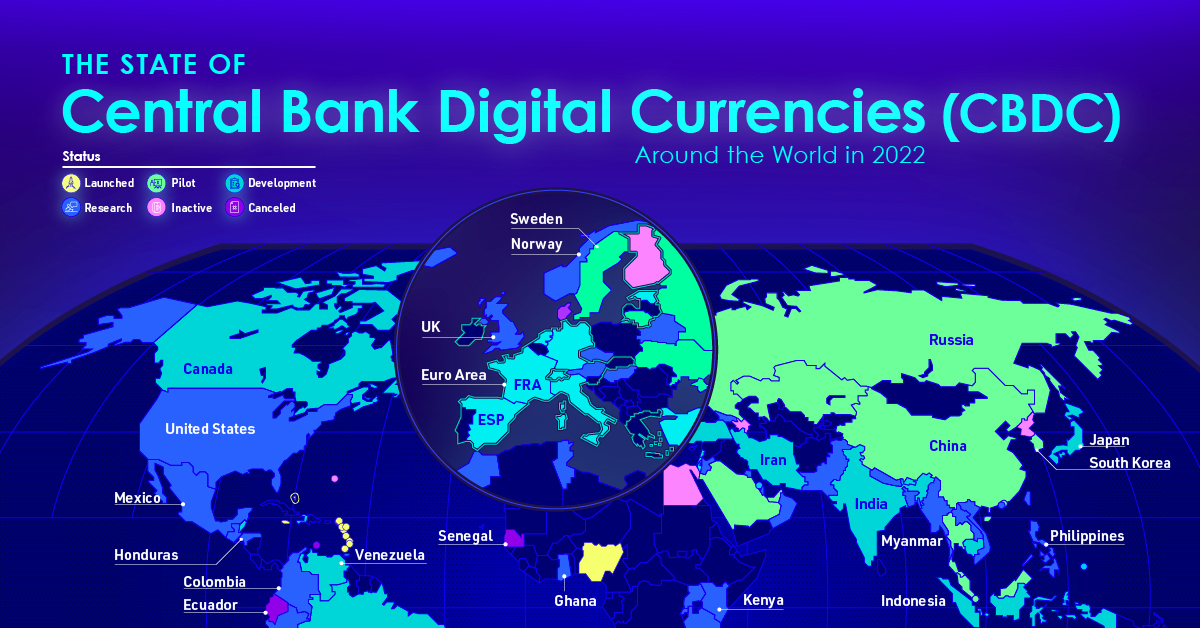Technology
Visualized: The State of Central Bank Digital Currencies
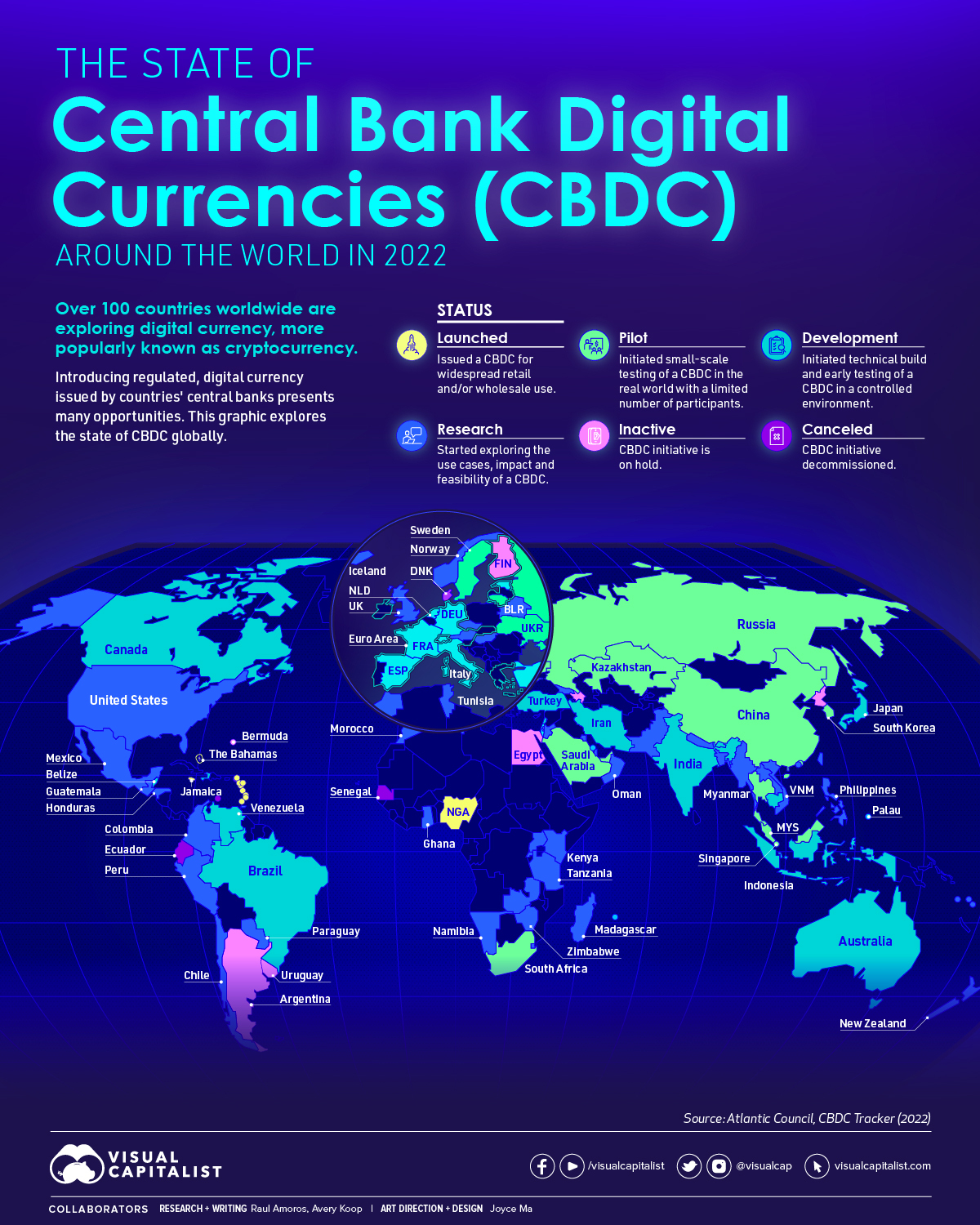
Visualized: The State of Central Bank Digital Currencies
Central banks around the world are getting involved in digital currencies, but some are further ahead than others.
In this map, we used data from the Atlantic Council’s Currency Tracker to visualize the state of each central banks’ digital currency effort.
Digital Currency – The Basics
Digital currencies have been around since the 1980s, but didn’t become widely popular until the launch of Bitcoin in 2009. Today, there are thousands of digital currencies in existence, also referred to as “cryptocurrencies”.
A defining feature of cryptocurrencies is that they are based on a blockchain ledger. Blockchains can be either decentralized or centralized, but the most known cryptocurrencies today (Bitcoin, Ethereum, etc.) tend to be decentralized in nature. This makes transfers and payments very difficult to trace because there is no single entity with full control.
Government-issued digital currencies, on the other hand, will be controlled by a central bank and are likely to be easily trackable. They would have the same value as the local cash currency, but instead issued digitally with no physical form.
Central Bank Digital Currencies Worldwide
105 countries are currently exploring centralized digital currencies. Together, they represent 95% of global GDP. The table below lists the data used in the infographic.
| Country | Status | Use Case |
|---|---|---|
| Nigeria | Launched | Retail |
| The Bahamas | Launched | Retail |
| Jamaica | Launched | Retail |
| Anguila | Launched | Retail |
| Saint Kitts and Nevis | Launched | Retail |
| Antigua and Barbuda | Launched | Retail |
| Montserrat | Launched | Retail |
| Dominica | Launched | Retail |
| Saint Lucia | Launched | Retail |
| Saint Vincent and the Grenadines | Launched | Retail |
| Grenada | Launched | Retail |
| Sweden | Pilot | Retail |
| Lithuania | Pilot | Retail |
| Ukraine | Pilot | Undecided |
| Kazakhstan | Pilot | Retail |
| Russia | Pilot | Retail |
| China | Pilot | Both |
| Thailand | Pilot | Both |
| Hong Kong | Pilot | Both |
| South Korea | Pilot | Retail |
| Saudi Arabia | Pilot | Wholesale |
| United Arab Emirates | Pilot | Wholesale |
| Singapore | Pilot | Wholesale |
| Malaysia | Pilot | Wholesale |
| South Africa | Pilot | Both |
| Canada | Development | Both |
| Belize | Development | Undecided |
| Haiti | Development | Both |
| Venezuela | Development | Both |
| Brazil | Development | Retail |
| Turkey | Development | Retail |
| Iran | Development | Retail |
| Bahrain | Development | Wholesale |
| India | Development | Both |
| Mauritius | Development | Both |
| Bhutan | Development | Both |
| Cambodia | Development | Retail |
| Indonesia | Development | Both |
| Palau | Development | Both |
| Australia | Development | Both |
| Japan | Development | Both |
| Spain | Development | Retail |
| France | Development | Both |
| Netherlands | Development | Retail |
| Switzerland | Development | Wholesale |
| Italy | Development | Undecided |
| Germany | Development | Undecided |
| Estonia | Development | Retail |
| Lebanon | Development | Retail |
| Israel | Development | Retail |
| Euro Area | Development | Both |
| United States | Research | Retail |
| Mexico | Research | Retail |
| Guatemala | Research | Undecided |
| Honduras | Research | Undecided |
| Trinidad andd Tobago | Research | Undecided |
| Colombia | Research | Undecided |
| Peru | Research | Undecided |
| Paraguay | Research | Undecided |
| Chile | Research | Retail |
| Iceland | Research | Retail |
| UK | Research | Both |
| Morocco | Research | Retail |
| Ghana | Research | Retail |
| Namibia | Research | Undecided |
| Eswatini | Research | Both |
| Madagastar | Research | Retail |
| Zimbabwe | Research | Undecided |
| Zambia | Research | Undecided |
| Tanzania | Research | Undecided |
| Rwanda | Research | Undecided |
| Uganda | Research | Undecided |
| Kenya | Research | Retail |
| Tunisia | Research | Wholesale |
| Oman | Research | Undecided |
| Kuwait | Research | Retail |
| Jordan | Research | Undecided |
| Georgia | Research | Retail |
| Belarus | Research | Undecided |
| Norway | Research | Retail |
| Czech Republich | Research | Undecided |
| Pakistan | Research | Retail |
| Nepal | Research | Undecided |
| Bangladesh | Research | Undecided |
| Myanmar | Research | Undecided |
| Laos | Research | Both |
| Vietnam | Research | Undecided |
| Macau | Research | Undecided |
| Taiwan | Research | Both |
| Philippines | Research | Retail |
| New Zealand | Research | Retail |
| Vanuatu | Research | Undecided |
| Fiji | Research | Undecided |
| Tonga | Research | Undecided |
| Palestine | Research | Retail |
| Jordan | Research | Undecided |
| Austria | Research | Wholesale |
| Hungary | Research | Retail |
| Bermuda | Inactive | Undecided |
| Sint Maarten | Inactive | Retail |
| Curaçao | Inactive | Retail |
| Argentina | Inactive | Undecided |
| Uruguay | Inactive | Retail |
| Denmark | Inactive | Retail |
| Azerbaijan | Inactive | Undecided |
| Egypt | Inactive | Undecided |
| North Korea | Inactive | Undecided |
| Finland | Inactive | Retail |
| Ecuador | Cancelled | Retail |
| Senegal | Cancelled | Retail |
When aggregated, we can see that the majority of countries are in the research stage.
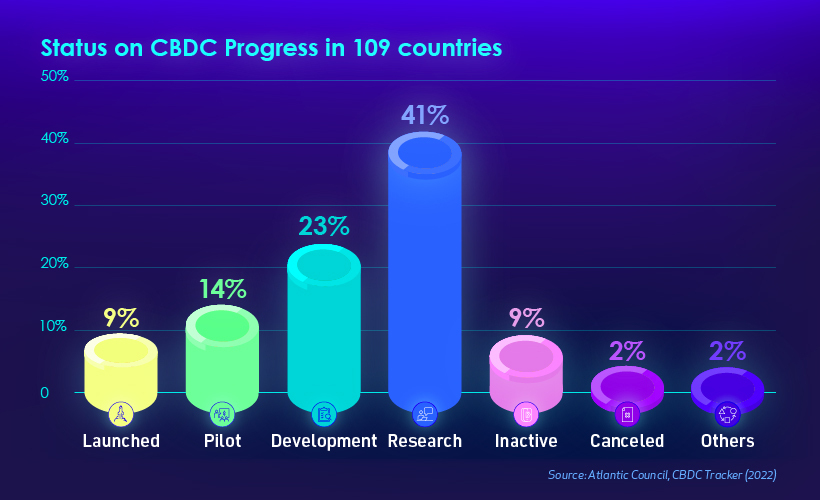
We’ve also divided the map by region to make viewing easier.
Africa
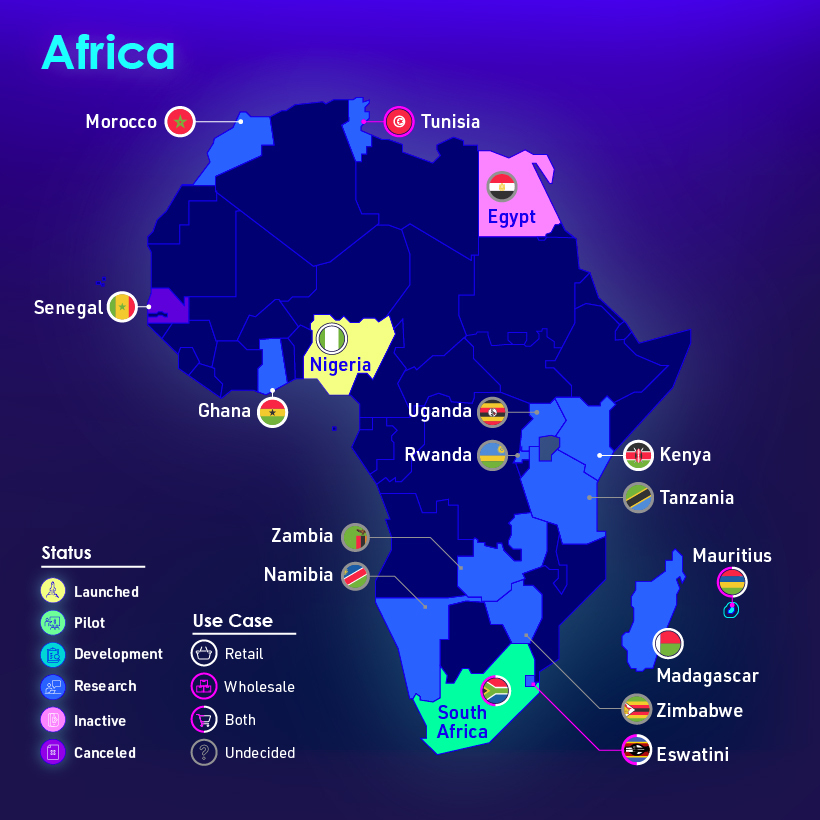
Asia
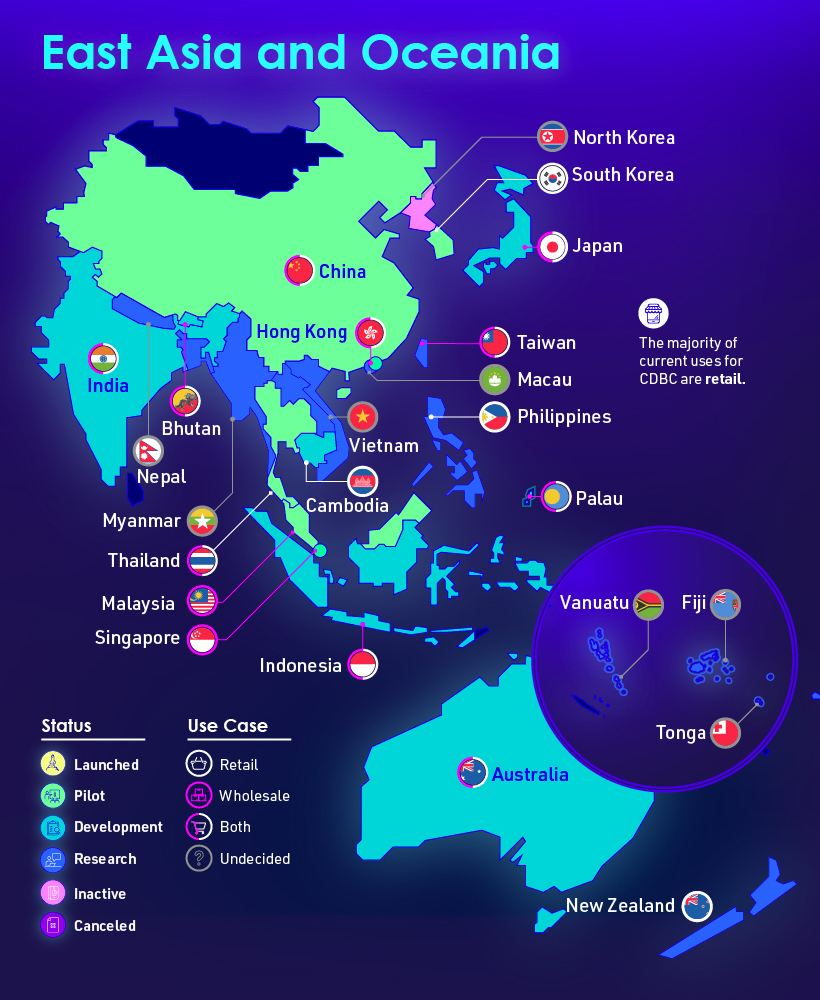
Europe
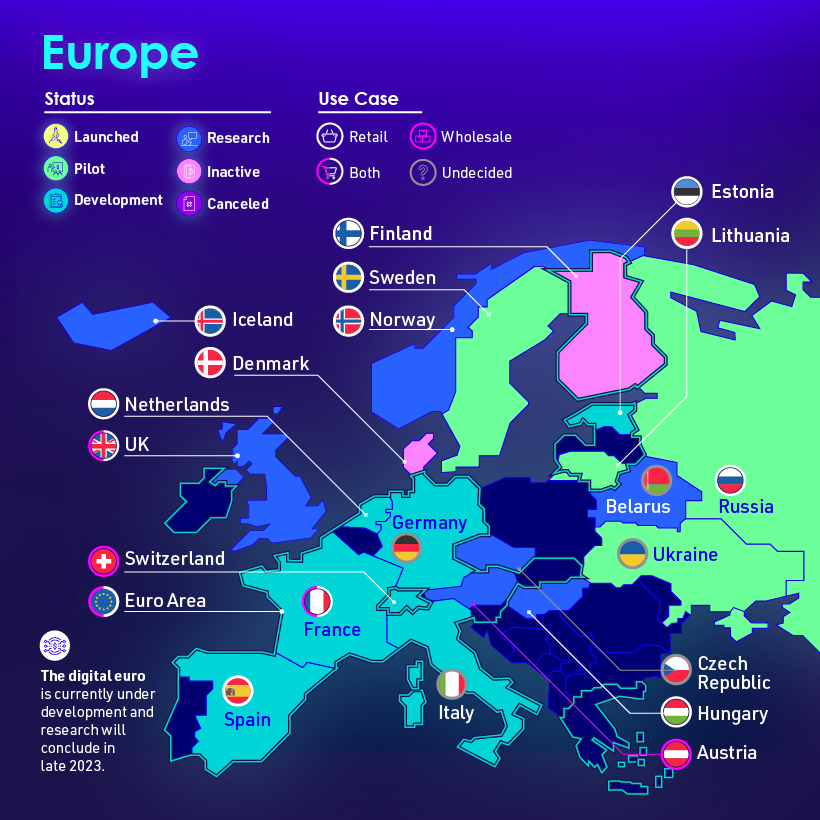
Middle East
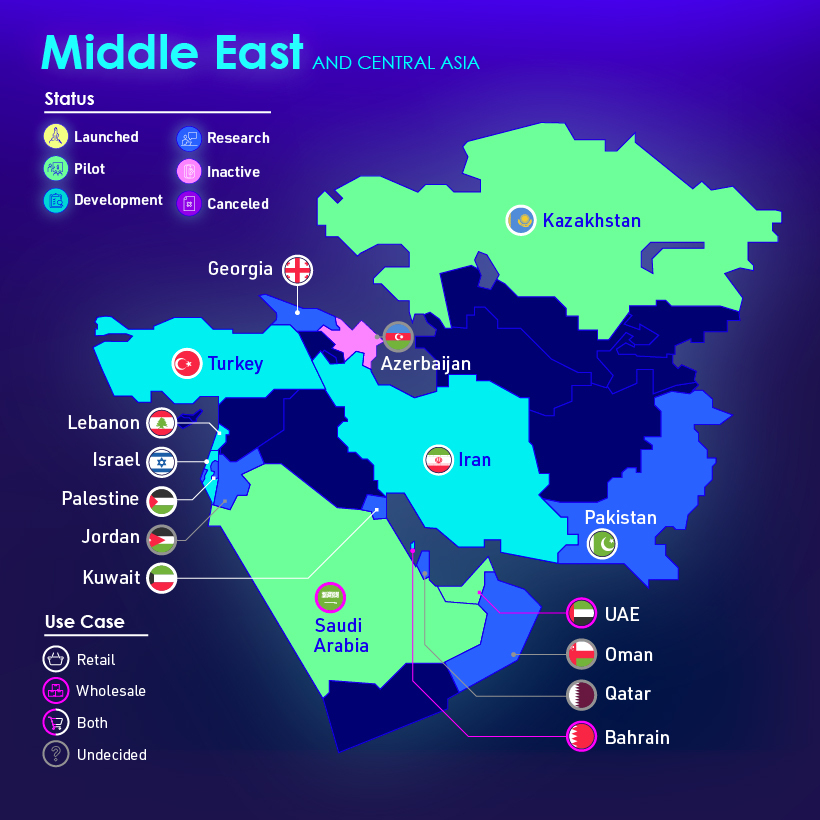
South America
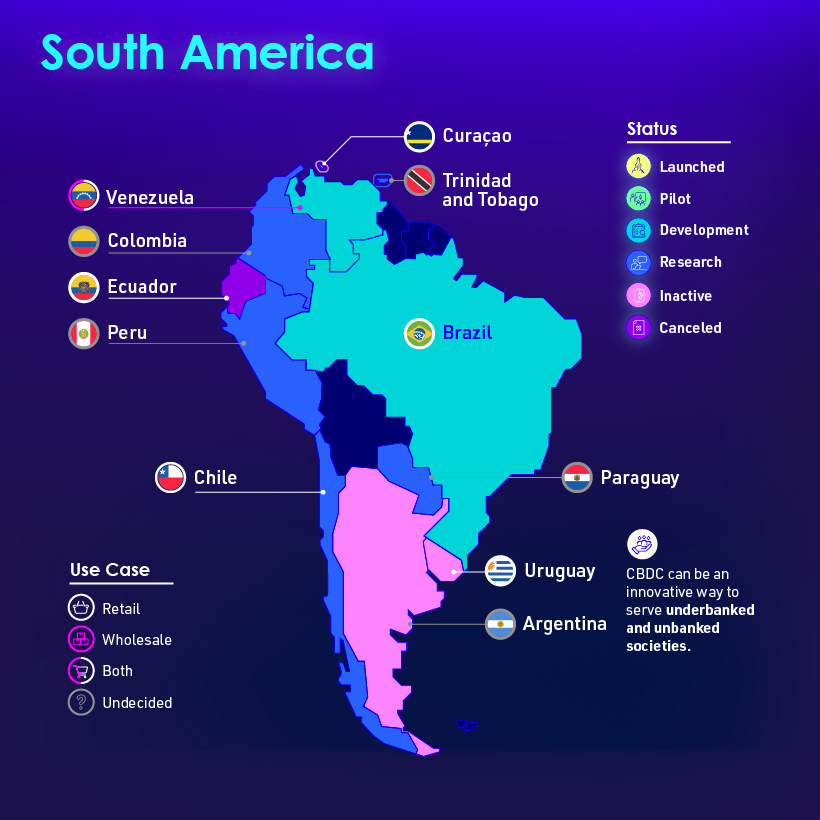
North America
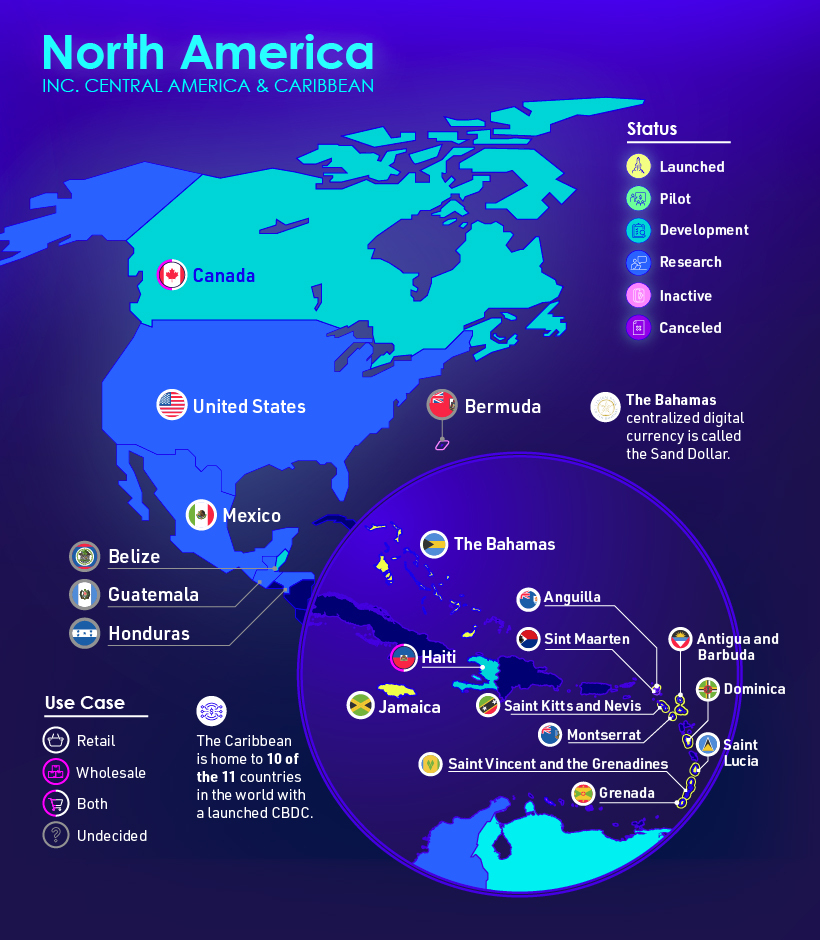
What are the Benefits?
A major benefit of government-issued digital currencies is that they can improve access for underbanked people.
This is not a huge issue in developed countries like the U.S., but many people in developing nations have no access to banks and other financial services (hence the term underbanked). As the number of internet users continues to climb, digital currencies represent a sound solution.
To learn more about this topic, visit this article from Global Finance, which lists the world’s most underbanked countries in 2021.
The 9%
Just 9% of countries have launched a digital currency to date.
This includes Nigeria, which became the first African country to do so in October 2021. Half of the country’s 200 million population is believed to have no access to bank accounts.
Adoption of the eNaira (the digital version of the naira) has so far been relatively sluggish. The eNaira app has accumulated 700,000 downloads as of April 2022. That’s equal to 0.35% of the population, though not all of the downloads are users in Nigeria.
Conversely, 33.4 million Nigerians were reported to be trading or owning crypto assets, despite the Central Bank of Nigeria’s attempts to restrict usage.
Status in the U.S.
America’s central bank, the Federal Reserve, has not decided on whether it will implement a central bank digital currency (CBDC).
Our key focus is on whether and how a CBDC could improve on an already safe and efficient U.S. domestic payments system.
– Federal Reserve
To learn more, check out the Federal Reserve’s January 2022 paper on the pros and cons of CBDCs.
Brands
How Tech Logos Have Evolved Over Time
From complete overhauls to more subtle tweaks, these tech logos have had quite a journey. Featuring: Google, Apple, and more.

How Tech Logos Have Evolved Over Time
This was originally posted on our Voronoi app. Download the app for free on iOS or Android and discover incredible data-driven charts from a variety of trusted sources.
One would be hard-pressed to find a company that has never changed its logo. Granted, some brands—like Rolex, IBM, and Coca-Cola—tend to just have more minimalistic updates. But other companies undergo an entire identity change, thus necessitating a full overhaul.
In this graphic, we visualized the evolution of prominent tech companies’ logos over time. All of these brands ranked highly in a Q1 2024 YouGov study of America’s most famous tech brands. The logo changes are sourced from 1000logos.net.
How Many Times Has Google Changed Its Logo?
Google and Facebook share a 98% fame rating according to YouGov. But while Facebook’s rise was captured in The Social Network (2010), Google’s history tends to be a little less lionized in popular culture.
For example, Google was initially called “Backrub” because it analyzed “back links” to understand how important a website was. Since its founding, Google has undergone eight logo changes, finally settling on its current one in 2015.
| Company | Number of Logo Changes |
|---|---|
| 8 | |
| HP | 8 |
| Amazon | 6 |
| Microsoft | 6 |
| Samsung | 6 |
| Apple | 5* |
Note: *Includes color changes. Source: 1000Logos.net
Another fun origin story is Microsoft, which started off as Traf-O-Data, a traffic counter reading company that generated reports for traffic engineers. By 1975, the company was renamed. But it wasn’t until 2012 that Microsoft put the iconic Windows logo—still the most popular desktop operating system—alongside its name.
And then there’s Samsung, which started as a grocery trading store in 1938. Its pivot to electronics started in the 1970s with black and white television sets. For 55 years, the company kept some form of stars from its first logo, until 1993, when the iconic encircled blue Samsung logo debuted.
Finally, Apple’s first logo in 1976 featured Isaac Newton reading under a tree—moments before an apple fell on his head. Two years later, the iconic bitten apple logo would be designed at Steve Jobs’ behest, and it would take another two decades for it to go monochrome.
-

 Green1 week ago
Green1 week agoRanked: The Countries With the Most Air Pollution in 2023
-

 Automotive2 weeks ago
Automotive2 weeks agoAlmost Every EV Stock is Down After Q1 2024
-

 AI2 weeks ago
AI2 weeks agoThe Stock Performance of U.S. Chipmakers So Far in 2024
-

 Markets2 weeks ago
Markets2 weeks agoCharted: Big Four Market Share by S&P 500 Audits
-

 Real Estate2 weeks ago
Real Estate2 weeks agoRanked: The Most Valuable Housing Markets in America
-

 Money2 weeks ago
Money2 weeks agoWhich States Have the Highest Minimum Wage in America?
-

 AI2 weeks ago
AI2 weeks agoRanked: Semiconductor Companies by Industry Revenue Share
-

 Travel2 weeks ago
Travel2 weeks agoRanked: The World’s Top Flight Routes, by Revenue




